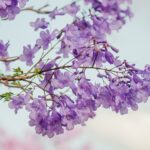Are you curious about the secrets hidden within the natural world? Do you yearn to unravel the mysteries that lie within its lush landscapes? Well, get ready to embark on a captivating journey as we delve into the enigmatic realm of indigo growth. In this article, we will peel back the layers of this vibrant plant’s habitat, uncovering its ecological significance and immersing ourselves in its rich cultural history. So, fasten your seatbelts and prepare to discover the answer to the intriguing question: Where does indigo grow?

Where Does Indigo Grow
Indigo, the extraordinary plant that yields a mesmerizing natural blue dye, holds a captivating history and an intriguing habitat. So, where does indigo grow? Let’s embark on a journey of discovery through the lush tropics, the arid subtropics, and the enigmatic realms of history and culture.
In its native state, indigo flourishes in the tropical and subtropical regions of Asia, Africa, and possibly China. This exquisite plant has been cultivated since ancient times and has even naturalized in various regions around the world. Imagine the sight of indigo’s vivid blue hues blending harmoniously with the vibrant landscapes of its origins.
Ever wondered what it takes for indigo to thrive? Although this resilient plant can adapt to various climates, it demands protection from excessive rainfall, water logging, and hailstorms. It prefers well-drained soil and warm temperatures to truly flourish. As we delve deeper into this mysterious natural dye, let’s appreciate the delicate balance that enables indigo to thrive in its favored ecosystems.
But how about its presence outside its native grounds? While indigo was once grown commercially in the southeastern United States, its cultivation has now shifted predominantly to India and South America, where labor costs are lower. This transition of indigo cultivation offers us a glimpse into how our world evolves, as regions adapt to changing economic and agricultural dynamics.
Indigo’s historical significance as a cash crop cannot be overstated. It holds a vital place in the fabric of human civilization, dating back to at least 4000 BCE. At that time, true indigo likely originated in China, tropical Asia, and parts of Africa, bearing witness to the passing centuries and the evolving tapestry of cultures that shaped our world.
Before we unravel the indigo plant’s cultural significance, let’s take a closer look at its physical attributes. Picture a robust evergreen shrub, standing tall at up to three meters in height. Its compound leaves, composed of three leaflets, glisten in the sunlight. Delicate white flowers with cheerful yellow centers bestow a touch of ethereal beauty. And within the fruit of indigo, lies the potential for new life, with each pod containing 1-4 precious seeds.
Intriguingly, indigo can be spotted along roadsides or nestled at the edges of forests, observing the world around it. As we venture further into exploring indigo’s ecological and cultural significance, let us not forget that nature often places its wonders just beyond our reach, inviting us to delve deeper into its mysteries.
Now, when we discuss indigo’s contemporary cultivation and commercial uses, we find ourselves drawn back to India and South America. These regions, with their favorable climates and lower labor costs, have become the leading cultivators of indigo plants for their valuable dye. As we ponder the convergence of natural resources and economic factors, we witness how the forces of human ingenuity and progress shape our world.
Indigo plants, with their lush green foliage and delicate flowers, also play a vital role in our ecosystem. They attract butterflies, offering a shimmering allure to the fluttering visitors. Within the diverse Indigofera genus, different species of indigo plants intertwine, showcasing their unique characteristics and hint at the potential of this remarkable perennial crop.
In conclusion, our exploration of indigo’s habitat and significance unveils a captivating tale. From its native territories of the tropics and subtropics to its historical and cultural ties, indigo continues to inspire awe and admiration. Its growth patterns, resilience, and the breathtaking blue dye it produces invite us to reflect on the intricate connections between nature and humanity.
So, let us celebrate the wonders of indigo, embrace its ecological and cultural significance, and cherish the mysteries it holds within. Take a moment to ponder the next time you encounter the mesmerizing blue hue of indigo, and let the timeless stories woven into this extraordinary plant captivate your imagination.
Indigo is a mesmerizing color that holds a rich history and fascinating secrets. Are you curious to uncover the intriguing facts about indigo? Click here to delve into the world of indigo and explore its captivating origins, traditional uses, and intriguing symbolism. Discover why indigo has captured the imagination of artists, designers, and cultures throughout the ages. Let’s embark on this exciting journey together! Facts about indigo
Where Does Indigo Grow
Indigo plants have a rich history and a vibrant allure that has captivated people for centuries. If you’ve ever wondered where these mesmerizing plants grow, you’re in luck. Indigo plants are known to flourish in various parts of the world. Whether you’re interested in indigo cultivation, indigo production, or simply want to learn more about these extraordinary plants, discovering their natural habitats is a fascinating journey.
If you’re eager to witness the beauty of indigo plants firsthand, you’ll want to explore the wonders of indigo cultivation. By clicking this link, you’ll unveil the secrets of cultivating indigo plants and delve into the techniques used to nurture their growth. Get ready to be amazed as you discover the intricate process behind cultivating these captivating plants. [[indigo cultivation|../indigo-cultivation]]
When it comes to indigo production, there is an entire world of possibilities waiting to be explored. Dive into the world of indigo production by clicking this link and witness the fascinating transformation from plant to dye. Uncover the methods and techniques utilized to extract the vibrant blue pigment from indigo plants. Join us on this incredible journey of indigo production and prepare to be amazed. [[indigo production|../indigo-production]]
If you’re intrigued by the concept of indigo plants and want to learn more about their origins and distribution, follow this enticing link. Discover where indigo plants flourish and uncover the lush landscapes they call home. From the vast fields of indigo plants to the serene valleys, the journey to uncovering their natural habitats is an expedition worth embarking on. Explore the fascinating world of indigo plants and satisfy your curiosity about their geolocation. [[indigo plants|../indigo-plants]]
FAQ
Q: Where is indigo native to?
A: Indigo is native to the tropics and subtropics of Asia, Africa, and possibly China.
Q: Can indigo grow in different climates?
A: Yes, indigo can grow in various climates, but it needs to be protected from excessive rainfall, water logging, and hailstorms.
Q: Where is indigo mostly grown commercially?
A: Indigo is mostly grown commercially in India or South America due to lower labor costs.
Q: Was indigo once grown commercially in the southeastern US?
A: Yes, indigo was once grown commercially in the southeastern US from the 1700s onwards, but it is not grown commercially in North America anymore.
Q: What are the characteristics of indigo plants?
A: Indigo plants are evergreen shrubs that can grow up to 3 meters in height. They have compound leaves composed of three leaflets, small white flowers with yellow centers, and fruit containing 1-4 seeds each.















